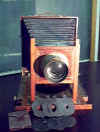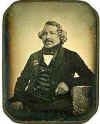
 SM015
Photographic plate camera circa
1940 Light
SM015
Photographic plate camera circa
1940 Light
Photography is the art of producing permanent images of objects by
utilizing the changes that certain substances undergo in the presence of
light.
The darkening effect of light on silver chloride was known to the
alchemists of the sixteenth century.
In 1802 Thomas Wedgewood and Humphry Davy published a paper on
producing profiles on glass plates utilizing silver nitrate.
In 1810 Seeback produced an image of the solar spectrum on paper coated
with silver chloride with intensity proportional to the actual intensity
of the various colours.
In 1814 Niepce used a process called ‘heliographie’ using a metal
plate coated with bitumen in oil of lavender and exposing in a camera
using a process of development of the plate after exposure.
In 1839 Daguerre in Paris and Fox Talbot in England
published details of their respective practical processes of producing
images by photography.
In 1850 Archer and Fry produced pictures using collodion as the carrier
of the sensitive emulsion with very good results.
In 1871 Dr. Maddox demonstrated that the sensitivity of the
emulsion is increased if gelatine is used as the emulsifying agent.
Gelatine emulsions on glass and paper can be exposed dry and
chemically developed afterwards.
So the image of the camera can be permanently fixed as a silver
image.
The photographic lens, which played such an important part in
photography, was invented in the earliest years.
William Wollaston invented the first lens in 1812.
In 1831 Charles Chevalier made an improved lens using flint glass
to correct aberrations. Joseph
Petzval invented a faster lens in 1841 using a combination of telescope
objectives with a space between the elements.
 Daguerre
Daguerre
![]()
 Museum
Museum
![]()
 SM015
Photographic plate camera circa
1940 Light
SM015
Photographic plate camera circa
1940 Light![]()